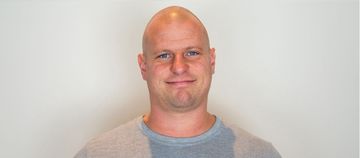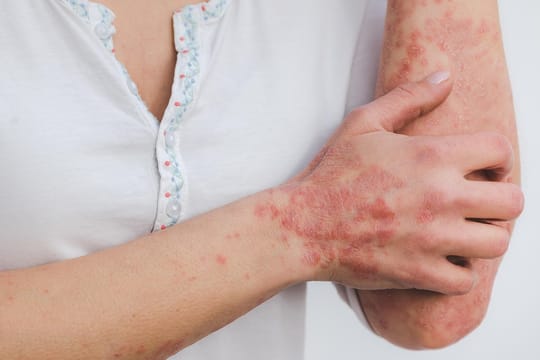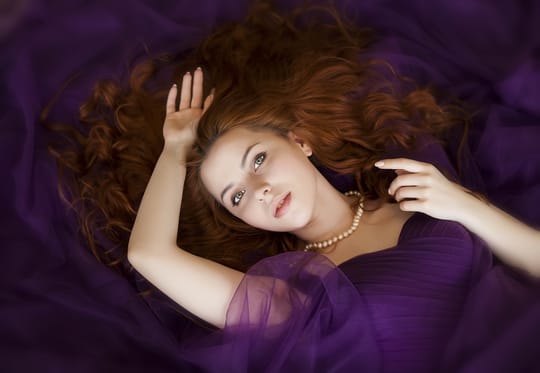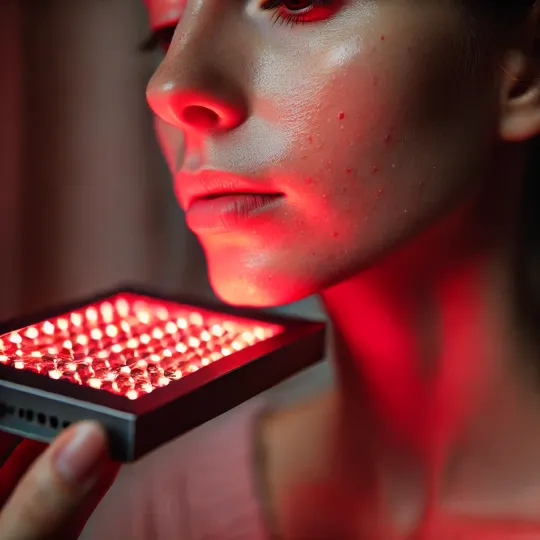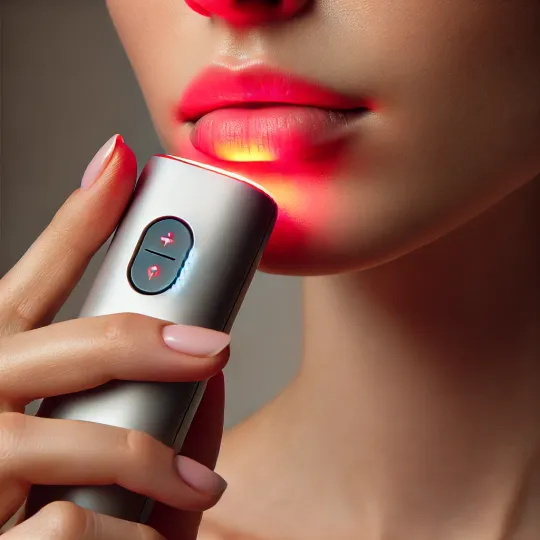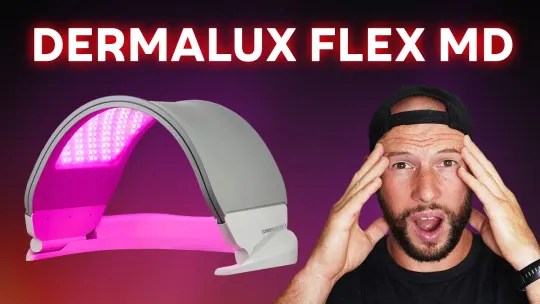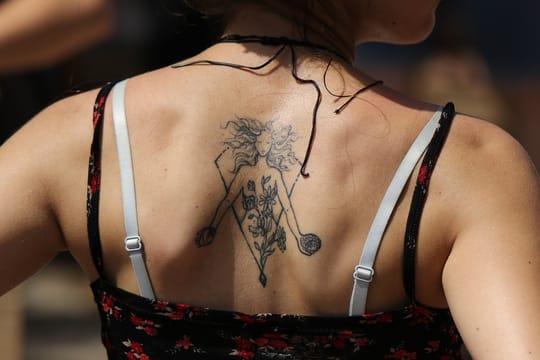So I decided to dig deeper into the red light therapy mask science. That's part of a bigger plan to write about red light therapy and skin health in much more detail on this blog.
Red light therapy masks are really popular. That's because skin health is one of the most important topics many people are interested in, next to pain maybe and brain health and muscle recovery.
In this blog post I will break down all available studies existing on masks that are currently out there. I consider these studies one by one and in great detail. Many of these studies have only been published in the last few years since masks became really popular.
What Are Red Light Therapy Masks?
So what are red light therapy masks? Simply put, masks are an LED device that you wear on your face that has either LEDs and lasers. These LEDs and lasers emit light and that light is rejuvenating to your skin - at least that's the goal.
You can see from some examples of Alex Fergus testing masks below that they're kind of funny looking:
In the video above, you can see Alex's results he's gotten with the Omnilux Men's Mask (if you want that mask, click the link and the discount automatically applied!). And in the next video you'll see the Jovs 4D laser beauty mask:
Discount code ALEX10 saves on the Jovs 4D.
But, I'm not here today to review masks but to talk about the science on this topic instead. So let's get into that:
Red Light Therapy Mask Studies Deep-Dive Breakdown
Check all the studies I consider one by one below:
Study 1: Red Light Therapy Masks Counter Acne Lesions By 20-24%
So first up there's a mask study that uses an over-the-counter mask for treating acne (1; 2). The study also used medication to impede acne, salicylic acid and retinol.
The silacydic acid is a skin peel product that's commonly used against acne (3; 4; 5). The silacydic acid impedes the fatty acid creation in sebocytes, which give rise to the acne, and impede inflammation. Apparently, the medication has few side effects but I'd also like to see more long-term human studies.
Retinol, moreover, is good old-fashioned vitamin A (6; 7; 8). In some studies putting retinol on your skin reduces acne lesion counts by 50%. And I've heard people using retinol on the skin for beauty effects very successfully as well.
But back to the mask study. A combination of 445nm blue light and 630nm red light was used. Males and females between 12 to 35 years old were included in the 12-week study.
These men and women had different skin types (the Fitzpatrick categorization), with lighter skin and darker skin. Both inflammatory and non-inflammatory lesions were measured. The main outcome of the study was this:
"445nm/630nm light therapy mask-treated subjects showed a 24.4-percent improvement in inflammatory acne lesions (p<0.01) versus 17.2 percent (p<0.05) and 22.7 percent (p<0.01) in benzoyl peroxide and 445nm/630nm light therapy mask with topical 1% salicylic acid with retinol, respectively, a 19.5-percent improvement in noninflammatory lesions (p<0.001) versus 6.3 and 4.8 percent for benzoyl peroxide and 445nm/630nm light therapy mask with topical 1% salicylic acid with retinol, respectively." (2).
So, the mask-only group did the best overall out of any groups, even better than the mask and medication combination group.
Inflammatory acne lesions were reduced by 24% and non-inflammatory lesions by almost 20%. This was for mild to moderate acne.
Now here's the interesting part: the researchers used an Illumimask. You can see that mask below:

The mask doesn't even have many LEDs and seems to be one of the earliest LED mask types that hit the market. The study I'm considering here is from 2016 and back then the red light therapy space wasn't as developed.
So the mask used in this study was one of the earliest prototypes and still reduced acne lesions by 20-24%. Alex has tested one of these earlier mask types, the Darmabeam Mask Pro, and the power output is really low.
Check Alex's review of the Dermabeam Mask Pro below:
Treatment in the mask-only group in this study was once daily. I'm only including that information because I assume most people here will want to stay away from using medication (except maybe for the natural retinol).
You can also see that the results in the inflammatory lesion count continued increasing in the mask study over a 12-week period:

Source (2).
And, for the non-inflammatory lesions the mask group did far better even:

Source (2).
Also, not everyone in the study got results. About 66% of the mask group was a full responder and 78% was a responder.
At the end of the research paper, the scientists also state the following, about the importance of combining blue and red light for acne:
Light therapy has become widely used for the treatment of acne. Although blue light has a somewhat limited depth of skin penetration, it is the most effective visible wavelength for treating P. acnes because it produces the strongest photoactivation of endogenous porphyrins. In addition to deeper penetration, red light also has anti-inflammatory effects and is beneficial for the treatment of inflammatory acne lesions. Thus, greater clinical improvement is associated with combined red and blue light therapy. (2).
Overal, my opinion is that this is pretty good stuff because even lower power output masks can get you great effects, apparently!
Study 2: Mask Use Can Slightly Improve Skin Brightness
So next up there's a study on using a red light therapy mask and its effect on skin brightness (9). Some people are worried about red light therapy discoloring their skin.
This study was a case report and only included one participant. The 44-year-old woman used a mask daily for 20 minutes. The mask contained 72 LEDs and emitted light between 650 and 840nm. Before and after pictures were taken to measure the effect.
The outcome here is that red light therapy mask use improved skin brightness. I don't want to go into this topic too much because the study only includes one participant, but the result is probably important to mention.
Study 3: 23-70%+ Improvement In Skin Quality Such As Crow's Feet, Skin Roughness, And Dermis Density
In this study, a "Skin Light Dior × Lucibel Mask" was used (10; 11). Red light at 630nm is emitted by that mask. I can't find a link to the mask anymore online right now, so the product might have been discontinued - I remember that the mask was priced very steeply at 4,000 Euros - which, in my opinion, is insane.
Nevertheless, the study is really impressive. Twenty women were included in the study. The researchers measured a wide array of properties of the facial skin during a three-month period:
"the antiwrinkle effect by measuring the depth of the crow's feet wrinkle, the relaxation of the oval of the face by clinical scoring, the firmness and elasticity of the skin by cutometric measurement, the density of the dermis by ultrasound analysis, the smoothness of the skin by measuring the roughness at the cheek, the homogeneity of the complexion by chromametric measurement, the diameter of the pores by macrophotographs and finally the sebo‐regulating effect by measurement of the rate of sebum and quantification of the number of pores containing porphyrin in the subjects presenting a mixed to oily skin. The satisfaction of the volunteers was also evaluated at the end of the study via a self‐questionnaire." (11)
The participants had increasing improvements over a three-month period. After three months, these were the outcomes:
Crows feet - wrinkles around the eyes - were reduced by 38%. Here you can see a picture from the study:

Skin sagging was reduced by 24%. Skin firmness improved by 23%. Skin elasticity improved by 17% and density by 47%. Skin roughness decreased by 23% and complexion improved by 34%. The diameter of pores improved by 32% - which you can see in the picture below:

Sebum levels - play part in the acne I talked about before - were lowered by 70%. And lastly, porphyrins in pores, which are related to an excessively oily skin, were lowered by 23%.
So overall there are massive improvements of skin quality across the board. What's also very interesting is the dose that is used - 15.6 Joules per cm2 over a 12-minute treatment time. Obviously that light is directly put on the skin with a mask, so you're going to have a stronger effect because there's no light reflection.
The results of this study are phenomenal though with massive skin quality improvements across the board. What's also interesting is that after 28 days, most of these results remain. So you're not losing out on all benefits if you go on a two-week holiday.
The next question is, should you get a Dior face mask for 4,000 Euros? My opinion is that you should absolutely not. Light is light and you can easily get a 15.6 J/cm2 dose using almost any other product on the market, with 630nm light. Also, if you want to know more about this topic, check out Alex's video on red light therapy dosing.
And there's more good news:
Study 4: Male Facial Improvement After Six Weeks Of Face Mask Use
So most of us men want to look great too. But many of us just don't want to admit it. Nevertheless, here's a red light therapy mask study in men that uses 633, 830, and 1072nm light (12).
The outcome of the study was simple:
"The participants reported overall favorable results and improvements in all individual categories, were satisfied with the treatment, and would recommend the product to others. The participants perceived the greatest improvement in fine lines and wrinkles, skin texture, and youthful appearance. Photographic digital analysis demonstrated favorable improvements in wrinkles, UV spots, brown spots, pores, and porphyrins." (12).
So, you're getting more or less the same results as the female counterparts!
Study 5: Combining A 660 And 850nm Light Mask With Hyaluronic Acid
In this 2020 study, two groups were compared. One group received a hyaluronic acid treament while the other received the hyaluronic acid and used a red light therapy mask with 660nm and 850nm (13).
Apparently hyaluronic acid is one of the supplements that counters skin aging (14; 15; 16). A recent study, for instance, showed the following results with hyaluronic acid:
"The [hyaluronic acid] serum demonstrated excellent tolerability and produced an increase in skin hydration (as measured by corneometry) immediately after application of 134% (p < 0.001), with a sustained increase of 55% (p < 0.001) at week 6. At week 6, there was also improvement (p ≤ 0.001) in all evaluated attributes: smoothness (64%), plumping (60%), hydration (63%), fine lines (31%), wrinkles (14%), and overall global assessment (43%)." (16).
So, once again, improvements across the board. But in the mask study that I'm considering here, the results of the group that combined the red light therapy and hyaluronic acid had the best results (13)!
Looking at the numbers, improvements were about double by adding the red light therapy to the hyaluronic acid.
The results were synergistic, so to speak, so mutually supportive and reinforcing. A Cellreturn LED Mask Platinum was used in this study. That mask does look impressive as it has over 1,000 LEDs in the fourth iteration. The current 4th generation of the mask also includes blue and violet light, which aren't included in the product used in the study as that only used 660 and 850nm.
Nevertheless, it's quite an interesting outcome and teaches that you may want to combine hyaluronic acid serum with red light therapy for the best results!
What Should You Think About These Red Light Therapy Mask Studies?
So, obviously, the red light therapy mask studies have super positive outcomes. But what do you know about the products that are used? Well, the following:
- The first study used 445nm blue light and 630nm red light successfully. The power output of that mask can be expected to be quite weak though.
- The second study combined 650nm red and 840nm near-infrared light, through a mask that has 72 LEDs.
- The third study used 630nm for a total dose of 15.6 J/cm2 and had exceptional results with a 12-minute treatment time. That a dose of 21 mW/cm2.
- The fourth study used 633, 830, and 1072nm light but not much can be read about the study characteristics.
- The fifth study uses the standard 660 and 850nm light.
If you want more information on some of these wavelengths, check:
- 660nm Wavelength Health Effects Cheatsheet
- The 830nm Wavelength Health Effects Cheatsheet
- 850nm Wavelength Health Effects: The Ultimate Guide
- 1,064nm (1,060nm) Wavelength Health Benefits: Everything You Need To Know
- Blue Light Therapy: Everything You Need To Know - for the 445 nm wavelength.
I'll add the 630nm guide in the near future as well!
But suffice it to say, a wide array of wavelengths seem to work in a red light therapy mask. Intuitively, it seems that the 630nm light does have the greatest benefit, judging from the Dior study, though. That same Dior study uses 21.6 mW/cm2.
Also, Alex just published a video on that Dior study that you can watch here:
Overall though, a wide array of wavelengths apparantly works in these mask studies. I hope we see dozens of new studies on LED masks in the near future, so that I can do a more elaborate breakdown of the topic!
Conclusion: LED Masks - Useful But It All Depends
So should you be using an LED mask if you want skin improvement? Arguably, these masks are helpful because you can use them while you're watching television, for instance, or during other activities.
For most people though, LED masks may not be the perfect answer as you can only treat one small part of your body at the same time and won't get the full benefits for your entire body. In that case, I recommend watching the comparison between red light therapy panels versus LED masks that Alex Fergus made.
Items Mentioned
- Illumimask
- Dermabeam Mask Pro - code ALEX saves
- Cellreturn LED Mask Platinum
- Light Therapy Insiders Shopping Tool - perfect for finding a panel that matches your requirements!
This is a post by Bart Wolbers. Bart finished degrees in Physical Therapy (B), Philosophy (BA and MA), Philosophy of Science and Technology (MS - with distinction), and Clinical Health Science (MS), has had training in functional medicine, and is currently chief science writer at Lighttherapyinsiders.com
